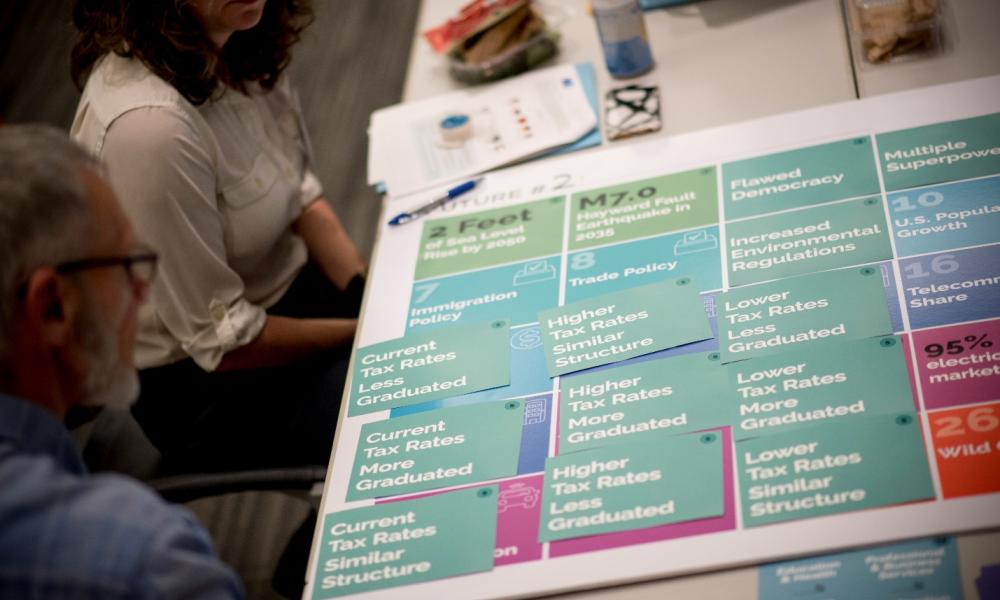Create-a-Future™
This in-person game created a suite of wide-ranging Futures for the Bay Area shaped by external forces beyond the control of residents and elected officials.

In April 2018, MTC and ABAG planners hosted the Horizon Peer Exchange to create a dozen unique “Futures,” defined by a suite of external forces that could affect the San Francisco Bay Area in the decades ahead. These divergent what-if scenarios transcended MTC and ABAG’s previous-scenario planning efforts by including a greater variety of political, technological, economic and environmental challenges that may impact Bay Area residents.
The activity involved a table exercise based on various external forces. In groups of four, participants defined 24 external force assumptions for their group’s Future. Each group had to work with two pre-defined external forces to ensure divergent Futures.
In the end, participants created 12 Futures primarily defined on the global and national scales, which were later narrowed down to three for further study by MTC and ABAG planners. The modeling inputs used for study were informed by the 24 external force assumptions set by participants, and the simulation models analyzed the Bay Area’s performance against each of the three Futures using status quo policies and investments. The findings from the analysis were then used in the next phase of the Horizon public engagement process—the Transform-the-Future game.
To learn more about the Create-a-Future™ game or to discuss how it could be leveraged for use in your organization’s scenario-planning process, please contact Dave Vautin at dvautin@bayareametro.gov.
During the Horizon peer exchange, participants were divvied up into groups of four led by an MTC/ABAG staff facilitator to complete the Create-a-Future™ tabletop exercise. The exercise involved a game board made up of 24 tiles that represented all the inputs (i.e., external forces) for creating a Future, plus two blank tiles that groups were able to add as external forces, if needed.
The external force tiles were divided into five categories: environmental, political, economic, land use and transportation external forces – all of which were outside of the control of the Bay Area. Participants then were asked to review a small subset of external forces pre-assigned to their group, which were intended to be the primary drivers in the group’s Future. At any point in the exercise, groups were allowed to remove up to one of the preassigned external forces with a unanimous vote if the group believed it was logically inconsistent with their other selections. Groups worked their way through the board section-by-section in the order that best fit their emerging narrative. The game ended once all 24 tiles were filled, after which the conceptual Future was presented to the full group of attendees to spur discussion of a broad and dynamic shortlist of what-if scenarios.
The groups created 12 Futures that were later narrowed down to three for use in “stress testing” public policies and investments, also referred to as strategies. The three Futures used in the Horizon process were called Clean and Green, Rising Tides, Falling Fortunes and Back to the Future:
Rising Tides, Falling Fortunes
Nationwide tax cuts and spending caps significantly reduce federal infrastructure funding. Combined with autonomous vehicles failing to live up to the hype, cities, regions, and states are forced to pay for much-needed traditional infrastructure projects themselves. Lack of regulatory action on climate change worldwide results in sea levels rising by three feet by 2050 – creating a new set of infrastructure needs in an era of slow growth.
Clean and Green
Recognizing the growing impacts of climate change, the federal government significantly tightens environmental regulations and implements an ambitious, nationwide carbon tax. New technologies thrive, with virtual reality enabling telecommuting and smaller-scale workplaces distributed across town centers. While high-tech manufacturing thrives in the United States, economic growth slows for other more energy-intensive sectors.
Back to the Future
The U.S. experiences continued prosperity and finds itself widely respected on the world stage, thanks to smart and strategic policy decisions on the national level. Rapid job growth means more people want to move to the U.S., and increased public investment in infrastructure makes the nation more attractive for businesses. Silicon Valley technologies are dominant worldwide in everything from cars to e-commerce. Wealthy Americans seek larger suburban homes, and many depend on new technologies such as autonomous vehicles and hyperloop lines to access urban job centers.


